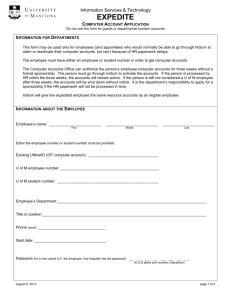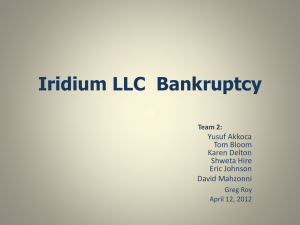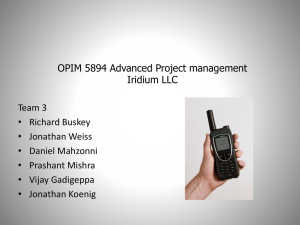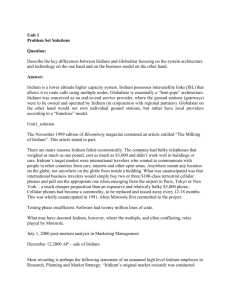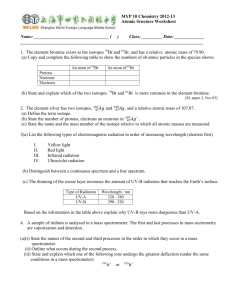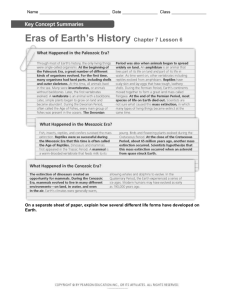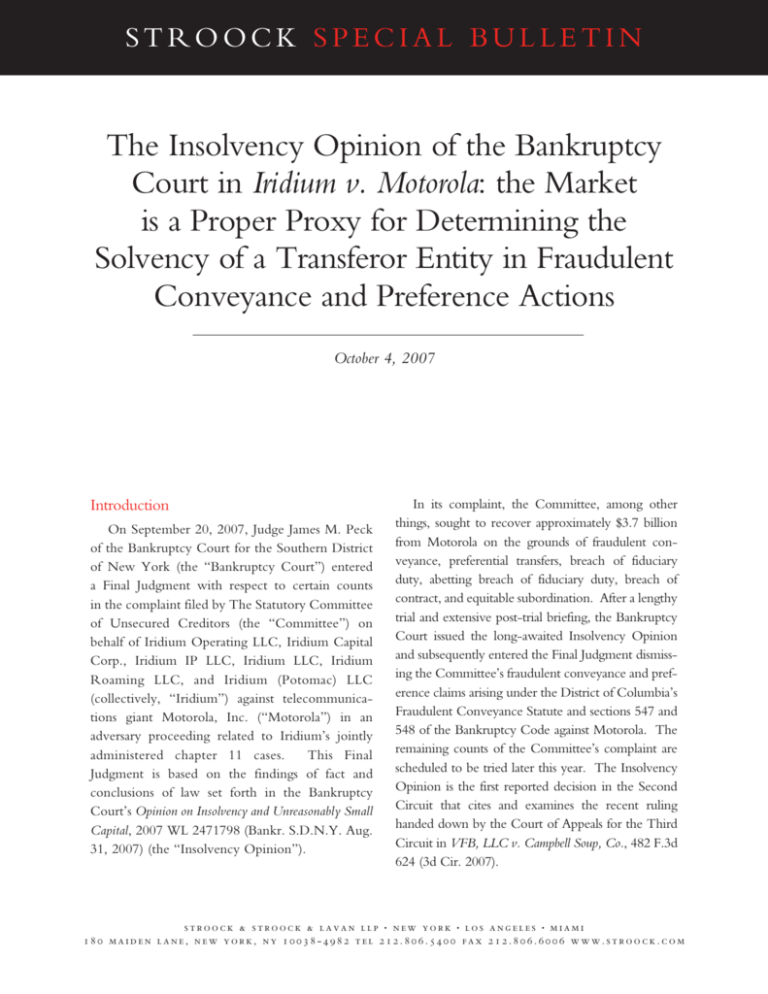
STROOCK SPECIAL BULLETIN
The Insolvency Opinion of the Bankruptcy
Court in Iridium v. Motorola: the Market
is a Proper Proxy for Determining the
Solvency of a Transferor Entity in Fraudulent
Conveyance and Preference Actions
October 4, 2007
Introduction
On September 20, 2007, Judge James M. Peck
of the Bankruptcy Court for the Southern District
of New York (the “Bankruptcy Court”) entered
a Final Judgment with respect to certain counts
in the complaint filed by The Statutory Committee
of Unsecured Creditors (the “Committee”) on
behalf of Iridium Operating LLC, Iridium Capital
Corp., Iridium IP LLC, Iridium LLC, Iridium
Roaming LLC, and Iridium (Potomac) LLC
(collectively, “Iridium”) against telecommunications giant Motorola, Inc. (“Motorola”) in an
adversary proceeding related to Iridium’s jointly
administered chapter 11 cases.
This Final
Judgment is based on the findings of fact and
conclusions of law set forth in the Bankruptcy
Court’s Opinion on Insolvency and Unreasonably Small
Capital, 2007 WL 2471798 (Bankr. S.D.N.Y. Aug.
31, 2007) (the “Insolvency Opinion”).
In its complaint, the Committee, among other
things, sought to recover approximately $3.7 billion
from Motorola on the grounds of fraudulent conveyance, preferential transfers, breach of fiduciary
duty, abetting breach of fiduciary duty, breach of
contract, and equitable subordination. After a lengthy
trial and extensive post-trial briefing, the Bankruptcy
Court issued the long-awaited Insolvency Opinion
and subsequently entered the Final Judgment dismissing the Committee’s fraudulent conveyance and preference claims arising under the District of Columbia’s
Fraudulent Conveyance Statute and sections 547 and
548 of the Bankruptcy Code against Motorola. The
remaining counts of the Committee’s complaint are
scheduled to be tried later this year. The Insolvency
Opinion is the first reported decision in the Second
Circuit that cites and examines the recent ruling
handed down by the Court of Appeals for the Third
Circuit in VFB, LLC v. Campbell Soup, Co., 482 F.3d
624 (3d Cir. 2007).
• • •
, , - .. .. ..
STROOCK SPECIAL BULLETIN
In other words, in order for the Iridium system to perform optimally, there must be little or no obstruction
between the antenna of a subscriber handset and the
satellite. In practical terms, this meant that the Iridium
system would have trouble working inside buildings
and vehicles as well as central business districts where
large buildings could block the signal from and to the
handset and the satellite. The system could work if, for
instance, at the exact moment a subscriber were inside
a building and near a window, it just so happened that
an orbiting satellite had a clear line of sight to the subscriber’s handset’s antenna.
During the 1990s, numerous investors participated
in Iridium’s debt and equity offerings. These investors
were sophisticated parties that undertook significant
technical and marketing due diligence regarding the
company and the Iridium system with the assistance of
equally sophisticated marketing and technical due diligence experts. Although there was conflicting evidence at trial as to how accurately and adequately
Iridium’s line-of-sight limitations were disclosed to
market participants, Motorola and Iridium maintained
that such limitations were disclosed to interested parties, and various documents provided to interested
investors included descriptions of the Iridium system’s
line of sight limitations.
Firms such as Gallup, Booz Allen Hamilton, and
AT Kearney conducted extensive market research to
assess the demand and to gauge the potential market
for Iridium’s services. In addition to the market
research, potential investors also reviewed Iridium’s
business plans and financial projections. Initially,
Iridium was expected to be a huge draw for the professional business traveler who needed access to
telecommunications services in remote areas of the
world where landline and cellular telephone services
were not readily available. Chase Securities, BZW,
and Barclays were the “Global Arrangers” for bank
loans extended to Iridium in the mid 1990s, and these
parties also engaged in extensive due diligence of
Background
Iridium is widely regarded as a spectacular failure of
the technology boom that occurred from the mid to
late 1990s. Prior to its bankruptcy, Iridium was touted as a telecommunications breakthrough that would
offer subscribers voice and data services through a network of satellites that orbited Earth. Conceived in the
late 1980s by a group of Motorola engineers, the
Iridium system is a satellite-based telephone system
that provides voice and paging services to subscribers
through the use of a handset that receives and sends
signals from the antenna of a subscriber handset to 66
low orbiting satellites. Originally, the system was supposed to have 77 satellites (the atomic number for the
element iridium on the periodic table), but it was ultimately decided by the engineers that 66 satellites
would be sufficient to provide the coverage Iridium
subscribers needed.
In the early 1990s, Iridium was spun off from
Motorola as an LLC, with Motorola remaining
involved in the development of the project. Iridium
LLC and Motorola entered into a series of contracts
such as the Space System Contract, the Operations
and Maintenance Contract and the Terrestrial
Network Development Contract. Under the Space
Systems Contract, Motorola was obligated to serve as
the primary contractor for the design, development,
production, operation and deployment of the Iridium
satellite constellation and to maintain the center that
controlled the satellite network. In addition,
Motorola was responsible for the development of the
gateways that connected the satellites to a terrestrial
communication network.
Motorola conducted tests to assess the Iridium system’s service capabilities. Among the limitations of
the Iridium system was the requirement that there be
a clear line-of-sight between the antenna of a subscriber’s handset and the satellite orbiting in space in
order to access and use the Iridium system’s services.
STROOCK SPECIAL BULLETIN
ance, and ultimately, to creditors filing an involuntary
petition against Iridium in August 1999. By
September 1999, all of the Iridium entities had filed
voluntary petitions in the Bankruptcy Court. During
the course of Iridium’s bankruptcy cases, its assets – the
satellite system – were sold to a group of investors for
$25 million, a fraction of what it cost to build and
develop the Iridium system.
Iridium in order to determine Iridium’s ability to service its debt. The Global Arrangers engaged Coopers
& Lybrand to perform business due diligence, and
Coopers & Lybrand in turn essentially concluded that
Iridium’s financial projections were reasonable.
Indeed, Iridium was able to raise a significant
amount of capital through a series of equity and debt
offerings that involved the participation of firms such
as Goldman Sachs, Salomon Smith Barney, and
Merrill Lynch. These firms were all aware of the
Iridium system’s capabilities as well as its line-of-sight
limitations. As a result of the interest in Iridium,
throughout 1997 and 1998, Iridium’s stock price
ranged from $17 to above $70, which implied an
equity valuation between $2.3 and $10 billion. From
January 1998 to January 1999, analysts that were
aware of the Iridium system’s line-of-sight limitations
estimated that Iridium had an equity value ranging
from $4 billion and $14 billion. Moreover, based on
its examination of the company’s financials as of
December 31, 1996, 1997 and 1998, KPMG, which
had been retained to develop financial models to be
used to generate and analyze the subscriber and revenue estimates contained in Iridium’s business plans,
concluded that Iridium would be able to meet its
obligations as they became due and that Iridium’s
financial projections were reasonable.
In November 1998, the Iridium system was
launched commercially. The Iridium system’s performance, however, was affected by technical problems and software issues and fell below Motorola’s
and investors’ expectations. In addition, the final
version of the Iridium handset turned out to be
unwieldy, being both heavier and larger than predicted, and at $3,000 each, costing more than initially expected.
The disappointing performance of the Iridium system, and the lack of subscribers who actually signed up
to use the Iridium system, were among the factors that
led to a deterioration of Iridium’s financial perform-
The Committee’s Action Against Motorola
In July 2001, the Committee filed an adversary
proceeding seeking the avoidance of payments made
by Iridium to Motorola pursuant to the contracts
between the parties to develop and build the Iridium
system. The Committee also alleged that Motorola
breached its fiduciary duties as well as certain warranties related to the contracts between the parties,
and the Committee sought the subordination of
Motorola’s claims in Iridium’s chapter 11 cases. In
total, the Committee sought approximately $3.7 billion plus statutory interest from Motorola under
claims for fraudulent conveyance, preferential transfers, breach of fiduciary duty, and breach of contract.
To simplify the process of resolving the
Committee’s action against Motorola, the parties
agreed to bifurcate the trial. The first phase of the
trial would deal with the issue of whether Iridium
was insolvent when the transfers from Iridium to
Motorola pursuant to the contracts occurred.
Should the Committee fail to establish the statutory
element of insolvency, then its fraudulent conveyance and preference claims would fail as a matter
of law. The second phase of the trial would deal
with the contractual and equitable subordination
claims asserted by the Committee against Motorola.
After lengthy discovery and several pretrial
motions, the insolvency phase of the trial commenced on October 23, 2006. Numerous witnesses – both live and via designated videotaped deposi-
STROOCK SPECIAL BULLETIN
financial projections that Iridium was unable
achieve. Based on a discounted cash flow (“DCF”)
analysis (having eschewed other traditional valuation
methodologies), and after having made numerous
adjustments to Iridium’s projections to take into
account the line-of-sight limitations that the
Committee’s experts believed were not known to
respondents to the market research, the
Committee’s experts concluded that Motorola was
hopelessly insolvent during the times relevant to the
payments made by Iridium to Motorola.
Motorola’s experts, on the other hand, relying in
large part on the “efficient markets theory,” concluded that the value imputed by the market to
Iridium during the mid to late 1990s fairly reflected
Iridium’s enterprise value given the information
available to the market at that time. In addition,
Motorola’s valuation and solvency expert used not
only a DCF analysis but also a market valuation
approach to value Iridium, comparing Iridium’s
public stock price, debt offerings and other contemporaneous valuations to those of comparable companies. Motorola’s experts also examined third party
evaluations of Iridium, all of which indicated that
Iridium was a solvent company.
The Bankruptcy Court rejected the opinions of
the Committee’s experts.
Specifically, the
Bankruptcy Court found that the Committee’s
experts were not credible because their testimony
failed to refute the overwhelming market evidence
presented by Motorola that supported its contention
that Iridium was solvent during the periods when
the transfers from Iridium to Motorola occurred.
Among other things, the Bankruptcy Court took
issue with the fact that the Committee’s experts
picked only two relevant dates – March 30, 1995
and June 30, 1997 – to assess the solvency of Iridium
and the fact that the Committee’s experts ignored
many significant transactions that took place after
those dates. In the Bankruptcy Court’s view, the
tions – gave testimony and thousands of pages of
documents were introduced into evidence. At the
close of the Committee’s case, Motorola moved for
judgment as a matter of law, but the Bankruptcy
Court reserved ruling on this motion, and the trial
continued. Meanwhile, on March 30, 2007, the
Court of Appeals for the Third Circuit handed
down its opinion in VFB, LLC v. Campbell Soup
Co., 482 F.3d 624 (3d Cir. 2007). After the close of
Motorola’s case, post-trial briefing took place and
the Bankruptcy Court heard closing arguments on
June 5, 2007.
The Insolvency Opinion
On the eve of Labor Day Weekend 2007, the
Bankruptcy Court issued the 111-page Insolvency
Opinion. The Bankruptcy Court held that the
Committee had failed to prove by a preponderance
of the evidence that Iridium was insolvent, i.e., that
Iridium’s debts exceeded the value of all of its assets
at fair valuation, or that Iridium was inadequately
capitalized, i.e., that Iridium’s working capital projections made during the periods relevant to the
transfers from Iridium to Motorola were unreasonable. As is often the case in valuation disputes, the
Bankruptcy Court’s decision largely turned on the
credibility of the parties’ expert witnesses.
The Committee’s experts testified that Iridium
was grossly overvalued as a result of certain errors in
the market research developed by the market participants. Particularly, because of the wording of certain of the questionnaires used in the market surveys
that allegedly inadequately disclosed the line of sight
limitations of the Iridium system, respondents overstated their willingness to buy and use the Iridium
product. According to the Committee’s experts,
this information, which the Committee argued was
based on erroneous assumptions as to how the
Iridium system actually worked, led to inflated
STROOCK SPECIAL BULLETIN
Committee’s experts’ “election not to directly
address such obviously important capital markets
transactions is not an oversight, but a calculated
decision leading to the inference that [the
Committee’s experts’] analysis has been manipulated
. . . to express the opinion that Iridium was insolvent.” 2007 WL 2471798, at *48. More importantly, the Bankruptcy Court found that the
Committee’s experts’ adjusted projections were
“carried out with litigation bias and for the express
purpose of showing that Iridium was insolvent.” Id.
at *51. Thus, the Bankruptcy Court concluded that
the Committee’s experts’ work product “is not a
reliable starting point for a DCF analysis.” Id.
favored Campbell Soup. Co., and seeking, among
other things, to set aside the spin-off transaction as a
constructively fraudulent transfer. VFB contended
that the Specialty Foods Division was not worth the
$500 million paid by VFI.
The District Court found that based on the valuation evidence before it (particularly evidence
from the public equity and debt markets), the
Specialty Foods Division was worth more than the
$500 million debt that VFI acquired before the spin.
Accordingly, because VFI failed to prove that the
transferor entity was insolvent or rendered insolvent
as a result of the transfer, the District Court did not
avoid the transfer of the $500 million from VFI to
Campbell and VFB appealed.
Citing cases that found that the market is an
appropriate proxy for determining the value of a
company, the Court of Appeals for the Third
Circuit affirmed the District Court, stating that
“[a]bsent some reason to distrust it, the market price
is ‘a more reliable measure of the stock’s value than
the subjective estimates of one or two expert witnesses.’” 482 F.3d at 633 (citations omitted). As
the U.S. Supreme Court stated in Basic v. Levinson:
With the presence of a market, the market
is interposed between the seller and buyer,
and, ideally, transmits information to the
investor in the processed form of a market
price. Thus the market is performing a
substantial part of the valuation process
performed by the investor in a face-to-face
transaction. The market is acting as the
unpaid agent of the investor, informing
him that given all the information available
to it, the value of the stock is worth the
market price.
485 U.S. 224, 244 (1988).
In the Committee’s action against Motorola, the
Bankruptcy Court agreed with the Court of Appeals
in VFB, finding that the value of Iridium as assessed by
VFB, LLC v. Campbell Soup Co.
After considering the contemporaneous valuations of Iridium and the assessments of market analysts, the Bankruptcy Court concluded that Iridium’s
stock price was an adequate indicator of the company’s value. The Bankruptcy Court stated that “[a]
company’s stock price is an ‘ideal datapoint’ for
determining value.” Id. at *56. In making this
determination, the Bankruptcy Court referenced the
opinion handed down by the Court of Appeals for
the Third Circuit in VFB, LLC v. Campbell Soup
Co., 482 F.3d 624 (3d Cir. 2007). In VFB, the
Campbell Soup Co. (“Campbell”) disposed of certain underperforming subsidiaries and product lines
(the “Specialty Foods Division”) through a leveraged spin-off transaction whereby a new subsidiary,
Vlasic Foods International (“VFI”), took on bank
debt to purchase the Specialty Foods Division.
Eventually, VFI’s performance deteriorated and VFI
sold off the Specialty Foods Division and filed for
bankruptcy. VFI assigned its legal claims to VFB
LLC (“VFB”), which commenced an action against
Campbell, alleging that the disclosures related to the
spin-off were inaccurate and the transaction unfairly
STROOCK SPECIAL BULLETIN
Given the overwhelming weight of that market
evidence, it may be that the burden of proving
insolvency and unreasonably small capital simply could not be met under any circumstances,
regardless of the evidence adduced, in the wake
of the Third Circuit's VFB decision, an influential case that has helped to illuminate the
proper way to resolve the valuation questions
presented here.
Id. at *62 (emphasis added).
the market was a more reliable measure of Iridium’s
value than the subjective estimates of the Committee’s
expert witnesses. The Bankruptcy Court further
noted that even if the market eventually got it wrong
with respect to Iridium’s value, as evidenced by
Iridium’s failure and entry into bankruptcy,
[a]ny reader of The Wall Street Journal
knows that the markets are risky and
unpredictable and that share prices frequently are influenced by a variety of factors unrelated to the fundamentals and
potential of a particular company.
Nonetheless, the public trading market
constitutes an impartial gauge of investor
confidence and remains the best and most
unbiased measure of fair market value and,
when available to the Court, is the preferred standard of valuation.
2007 WL 2471798, at *4.
The Bankruptcy Court also found that the cash
flow projections contained in Iridium’s business plans
were reasonable given, among other things, investment banks’ analyses confirming Iridium’s managements’ expectations about the company’s future performance. The reasonableness of Iridium’s business
plans buttressed the conclusion that Iridium was
indeed solvent and adequately capitalized during the
periods relevant to the transfers the Committee sought
to avoid. As the Bankruptcy Court concluded:
The fact that Iridium failed in such a spectacular fashion stands out as a disturbing
counterpoint to the market’s optimistic
predictions of present and future value for
Iridium, but in the end, the market evidence could not be denied. The capital
markets synthesized and distilled what all
the smart people of the era knew or
believed to be true about Iridium.
Aftermath
On September 24, 2007, the Bankruptcy Court
tentatively scheduled the second phase of the trial,
which will address the Committee’s breach of contract, breach of fiduciary duties and equitable subordination claims against Motorola, to begin on
November 26, 2007.
________________________
By Lewis Kruger, a partner and co-chair of Stroock
& Stroock & Lavan LLP’s Financial Restructuring
Practice Group and James S. Gutierrez, an associate
in the Financial Restructuring Practice Group.
Lewis can be reached at 212.806.5430 or
lkruger@stroock.com. James can be reached at
212.806.5631 or jgutierrez@stroock.com.
STROOCK SPECIAL BULLETIN
New York
Maiden Lane
New York, NY -
Tel: ..
Fax: ..
Los Angeles
Century Park East
Los Angeles, CA -
Tel: ..
Fax: ..
Miami
Wachovia Financial Center
South Biscayne Boulevard, Suite
Miami, FL -
Tel: ..
Fax: ..
www.stroock.com
This Stroock Special Bulletin is a publication of Stroock & Stroock
& Lavan © Stroock & Stroock & Lavan . All
Rights Reserved. Quotation with attribution is permitted. This
Stroock publication offers general information and should not be
taken or used as legal advice for specific situations, which depend
on the evaluation of precise factual circumstances. Please note
that Stroock does not undertake to update its publications after
their publication date to reflect subsequent developments. This
Stroock publication may contain attorney advertising. Prior
results do not guarantee a similar outcome.
Stroock & Stroock & Lavan is a law firm with a national and
international practice serving clients that include investment banks,
commercial banks, insurance and reinsurance companies, mutual
funds, multinationals and foreign governments, industrial enterprises, emerging companies and technology and other entrepreneurial ventures.
For further information about Stroock Special Bulletins, or other
Stroock publications, please contact Richard Fortmann, Senior
Director-Legal Publications, at ...

